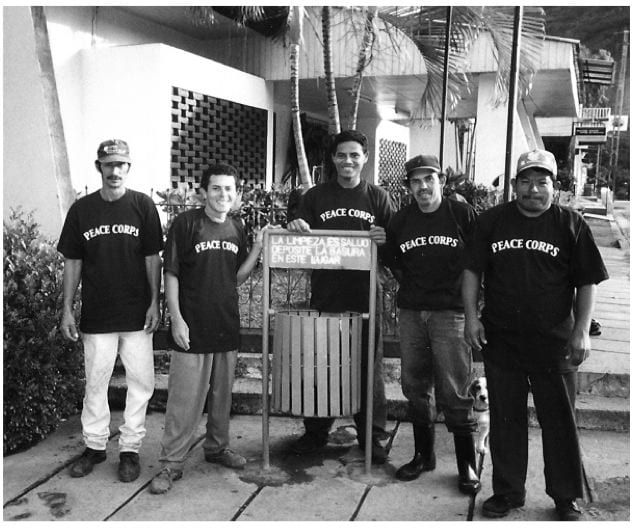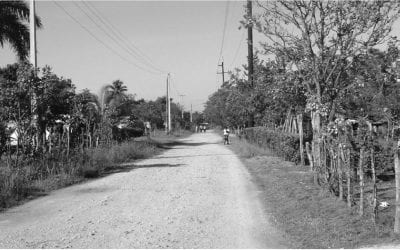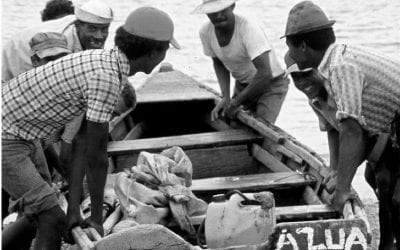Small Loans Fund Big Dreams
From Peace Corps to ACCION

Garbage men from la Trinidad wear Peace Corps T-shirts as thanks for their participation in a sanitation campaign. Photo by Cena Forster
Six weeks after graduating from Harvard’s class of 1999, I joined the Peace Corps and became an Environment Volunteer. I moved to Nicaragua with rudimentary Spanish skills, unquenchable optimism, and no real idea of what I was getting myself into. In 1960, when John F. Kennedy first presented the idea of what would become the Peace Corps, he asked a group of Michigan students how many of them were willing to serve their country and the poor by living and working abroad. He said, “On your willingness to do that, not merely to serve one year or two, but on your willingness to contribute part of your life to this country, I think will depend the answer to whether a free society can compete.” Unbeknownst to me at the time, my life became part of the answer to this question.
My Peace Corps site is a little place called La Trinidad—a town of about 10,000 people nestled in a valley surrounded by three hills, bordered on the north by a river, and parked on the Pan American highway. Originally, I had planned to do something practical with my Peace Corps service, like reforestation projects, but instead I was encouraged to spend my first year teaching environmental education in the rural elementary schools. During my second year, I organized a sanitation campaign and became the manager of a small savings and loan operation. This last project became my favorite – it provided $50 loans to single mothers to start or expand small businesses. I had never even heard of the word “microfinance,” and at first I was daunted by the idea that at the age of 24 with a degree in Environmental Science, I would be administering a program for women desperately in need of both working capital for their small businesses and the skills to make the most of that capital.
Every Monday afternoon, I would climb the rocky hill east of the Pan American highway to the poor neighborhood of Bella Vista, where many of my business ladies lived. Pastel pink and blue houses built with hurricane relief money brightened the muddy hillside and lined the gravelly roads where the municipal services failed to reach. I spent these afternoons sitting in the dirt-floored living rooms of these two-room houses, listening to the stories of the week’s worth of happenings in each family. They shared not only stories of dashed hopes and small triumphs, but also guiso de pipian, café con rosquillas, or tortillas con cuajada. I listened with compassion to stories of illness, alcoholism, and discrimination based on local politics; I listened with joy to stories about the children’s success in school, a good deal to be had this week on business inputs like bananas, and the quiet faith that everything would work out. And every week I politely but insistently asked for each of these women’s weekly payments. Some weeks were hard and I understood that a payment this week was not possible. But the following week I would return and the women would contribute what they could, striving to double the weekly payment and make up for the week before. At the end of our first year together, my weekly insistence and their weekly sacrifice had produced amazing results.
Doña Maria Salome was my only fully illiterate business woman; she would tell people it was her eyes that didn’t work well anymore now that she was older, but the truth was her father never let her go to school. So, I taught her oldest daughter who was still at home how to keep her mother’s books. Sometimes, as many parents will understand, her 14-year-old daughter refused to do the chores her mother asked of her, in this case writing down the sales and expenses for the week. On these occasions, Doña Maria would wait for my visit and recite from memory the full list of the week’s sales and expenses, so that I could bring her books up to date. With her first year’s savings, Doña Maria bought a fuel efficient cooking stove that saved money on firewood, reduced her consumption of trees, and provided a chimney that alleviated the eye and respiratory problems she and her daughters suffered due to the open wood fire in their home. This is the kind of success that is really triple bottom line: better for her pocketbook, better for the environment, better for her family’s health. The stove was such a success that on my weekly visits Doña Maria began to report how many of her neighbors came by and offered to buy it from her. She said she wouldn’t sell it to anyone, because she had worked so hard to save for it and was so proud of how it had been delivered by Peace Corps staff in their trademark white SUV. It also permitted her to make her day’s batch of tortillas in half the time as the open fire, allowing her to branch out into candy production as well.
Each of the women I worked with managed, over the course of the year, which included two six month loan cycles, to not only pay back their loans, but also to save about $1/week. For many of them, this amounted to more money than they had ever had in one place at one time before in their whole lives. Some of the women saved more and some saved less, but each managed to save enough for us to implement the next step in the business plan we had created together at the beginning of the year. What we were able to accomplish in the year we spent working together surprised all of us. I realized that a firm grasp of multiplication and the education of having been raised in a capitalist society was enough to change these women’s lives permanently for the better. They realized that despite the challenges of their circumstances, they had good business ideas, could save toward their goals, and could improve the life they provided for their families. All of them learned about the value of investing in their businesses and how saving can help achieve business and family goals. I learned that access to financial services is a powerful way of empowering women and reducing poverty.
At the close of my Peace Corps service, I treated all the women to a celebratory lunch to commemorate their successful completion of a year in the program. At this lunch Doña Maria said to me a most memorable thing. “Cara,” she said, “te agradecemos tanto por enseñarnos a trabajar.” And I thought to myself: here is a woman who raises seven children on $25 a week, who lived through the war, and built her house with her own hands, I couldn’t possibly have taught her anything about what it means to work. But I also understood what she meant, which was ‘thank you for showing us a better way to work, a way to make our work more effective, a way to make our dreams a reality on a time scale we can see.’ It was my year working with these women to help them see how to turn their own potential into an engine for achieving their dreams that made me passionately committed to microfinance as the best tool I know of to help end poverty. And it is toward that goal that I have been striving ever since.
It took me six years of varied experiences to finally attain my dream, and have the opportunity to dedicate my career to expanding the reach of microfinance to poor women worldwide. My Peace Corps experience gave me the determination necessary to see this dream through to its fulfillment. Now, I am a Program Manager for ACCION International’s new Center for Financial Inclusion. My program areas include consumer protection, social performance, and impact assessment, all of which help give the poor high quality financial tools so they can work their way out of poverty. We have just launched an industry-wide Campaign for Client Protection aimed at expanding clients’ access to financial services, while protecting client’s rights and staying focused on double bottom line results (both economic and social). I accepted President Kennedy’s challenge and joined the Peace Corps, and it is absolutely the best thing I have done with my life so far.
Cara S. Forster served as a Peace Corps Volunteer in Nicaragua from 1999 to 2001. She currently works as the Program Manager for the Double Bottom Line at ACCION’s Center for Financial Inclusion in Washington, DC. The Center’s website is http://www.centerforfinancialinclusion.org
Related Articles
Editor’s Letter: The Sixties
When I first started working on this ReVista issue on Colombia, I thought of dedicating it to the memory of someone who had died. Murdered newspaper editor Guillermo Cano had been my entrée into Colombia when I won an Inter American Press Association fellowship in 1977. Others—journalist Penny Lernoux and photographer Richard Cross—had also committed much of their lives to Colombia, although their untimely deaths were …
The True Impact of the Peace Corps: Returning from the Dominican Republic ’03-’05
I am an RPCV: a Returned Peace Corps Volunteer. For me the Peace Corps was an intense life experience, above anything else. As I continue to reflect on it, I am struck with the many and varied ways in which it continues to affect my life. As a PCV in the Dominican Republic from September 2003 to November 2005, I lived, worked, and learned in a small sugar cane-dependent community two hours outside of Santo Domingo…
In the Shadow of JFK: One Peace Corps Experience
I am often asked about the Peace Corps by students and recent graduates. The most frequent questions are, “why join?”, “what did you do?”, and “what has it meant for your career?” Here is my story. My earliest recollection of international curiosity was in the fourth grade when Sister Margaret Thomas described her experience as a recently returned missionary in Bangladesh. In high school, my sister Mary went to Peru on …



